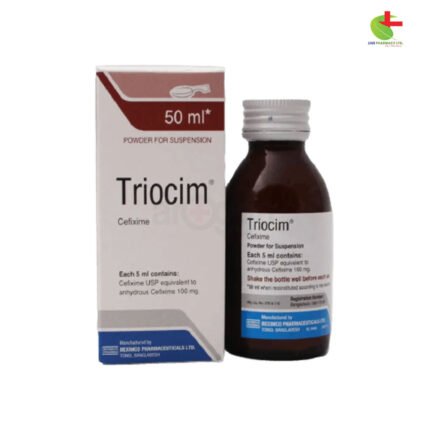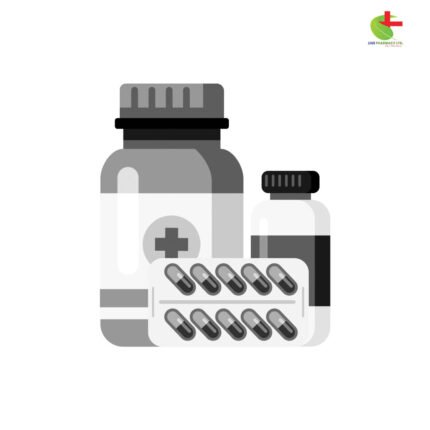Turbocef Suspension
240.00৳ Bottle (70ml)
- Turbocef is a broad-spectrum second-generation cephalosporin antibiotic.
- It is effective against various infections caused by sensitive bacteria, including respiratory, urinary tract, skin, and bone infections.
- Commonly prescribed for conditions such as pharyngitis, otitis media, pneumonia, and Lyme disease.
- Turbocef is available in both oral and injectable forms, suitable for pediatric and adult patients.
 Brand
Brand
|
Beximco Pharmaceuticals Ltd |
|---|---|
 Generics
Generics
|
Cefuroxime Axetil |
 Type
Type
|
Powder for Suspension |
Indications
This medication is prescribed to treat infections caused by bacteria susceptible to its effects, including:
- Pharyngitis/Tonsillitis: Caused by Streptococcus pyogenes.
- Acute Bacterial Otitis Media: Resulting from Streptococcus pneumoniae, Haemophilus influenzae, Moraxella catarrhalis (including beta-lactamase-producing strains), or Streptococcus pyogenes.
- Acute Bacterial Maxillary Sinusitis: Due to Streptococcus pneumoniae or non-beta-lactamase-producing strains of Haemophilus influenzae.
- Lower Respiratory Tract Infections (including pneumonia): Caused by Streptococcus pneumoniae, Haemophilus influenzae (including beta-lactamase-producing strains), Klebsiella spp., Staphylococcus aureus (both penicillinase and non-penicillinase-producing strains), Streptococcus pyogenes, or E. coli.
- Acute Exacerbation of Chronic Bronchitis and Secondary Infections of Acute Bronchitis: Due to Streptococcus pneumoniae, beta-lactamase-negative strains of Haemophilus influenzae, or Haemophilus parainfluenzae.
- Skin and Soft Tissue Infections: Caused by Staphylococcus aureus (including beta-lactamase-producing strains) or Streptococcus pyogenes.
- Urinary Tract Infections (UTIs): Caused by E. coli or Klebsiella pneumoniae.
- Bone and Joint Infections: Infections caused by both penicillinase and non-penicillinase-producing strains of Staphylococcus aureus.
- Gonorrhea: Both penicillinase-producing and non-penicillinase-producing strains of Neisseria gonorrhoeae.
- Early Lyme Disease (Erythema Migrans): Caused by Borrelia burgdorferi.
Pharmacology
Cefuroxime, an established broad-spectrum antibiotic, demonstrates potent bactericidal activity against a variety of common pathogens, including beta-lactamase-producing strains. It’s stable against bacterial beta-lactamase, making it effective against many strains resistant to ampicillin and amoxicillin.
Dosage
Tablets or Suspension (Oral):
Adolescents and Adults (13+ years):
- Pharyngitis/Tonsillitis: 250 mg twice daily for 5-10 days
- Acute Bacterial Maxillary Sinusitis: 250 mg twice daily for 10 days
- Exacerbation of Chronic Bronchitis: 250-500 mg twice daily for 10 days
- Secondary Bacterial Infections of Acute Bronchitis: 250-500 mg twice daily for 5-10 days
- Skin and Soft Tissue Infections: 250-500 mg twice daily for 10 days
- Urinary Tract Infections: 250 mg twice daily for 7-10 days
- Uncomplicated Gonorrhea: Single dose of 1000 mg
- Community-Acquired Pneumonia: 250-500 mg twice daily for 5-10 days
- MDR Typhoid Fever: 500 mg twice daily for 10-14 days
- Early Lyme Disease: 500 mg twice daily for 20 days
Pediatric Patients (3 months to 12 years):
- Pharyngitis/Tonsillitis: 20 mg/kg/day, twice daily for 5-10 days
- Acute Otitis Media: 30 mg/kg/day, twice daily for 10 days
- Maxillary Sinusitis and Impetigo: 30 mg/kg/day, twice daily for 10 days
Parenteral (Injection):
Adults:
- General Dose: 750 mg IM/IV three times daily. In severe cases, up to 1.5 g IV three times daily, potentially increasing frequency to four times daily if needed.
- Surgical Prophylaxis: 1.5 g IV at anesthesia induction, followed by 750 mg every 8 hours for high-risk surgeries.
- Pneumonia/Exacerbations of Chronic Bronchitis: 750 mg twice daily (IM or IV) for 2-3 days, followed by 500 mg orally twice daily for 5-10 days.
Children (Above 3 Months):
- 30-100 mg/kg/day IM/IV in 3-4 divided doses. A dose of 60 mg/kg/day is generally appropriate.
Neonates:
- 30-100 mg/kg/day in 2-3 divided doses.
Administration
For optimal results, freshly reconstituted solutions are recommended. These remain potent for 24 hours at room temperature and up to 48 hours at 5°C.
Interactions
No known hazardous interactions have been reported with this medication.
Contraindications
Cefuroxime is contraindicated in patients with known allergies to cephalosporins.
Side Effects
Adverse reactions are rare and generally mild, including rashes and gastrointestinal disturbances. Prolonged use may lead to the overgrowth of non-susceptible organisms such as Candida.
Use in Pregnancy & Lactation
Cefuroxime falls under US FDA pregnancy category B. Although animal studies do not indicate direct harm, this medication should be used in pregnancy only if clearly necessary. It is excreted in breast milk, so caution is advised for nursing mothers.
Precautions & Warnings
Use with caution in patients on potent diuretics or those with a history of colitis. While cefuroxime is generally safe for penicillin-allergic patients, cross-reactivity has been reported. Administer this drug according to the prescribed dosage levels to avoid complications.
Reconstitution
- For 750 mg IM Injection: Mix with 3 ml water for injection.
- For 750 mg IV Injection: Add 8 ml water for injection and administer slowly over 3-5 minutes.
- For 1.5 g IV Injection: Reconstitute with 16 ml water for injection and administer slowly over 3-5 minutes.
Storage Conditions
Store in a cool, dry place below 30°C, away from light and moisture. Keep out of the reach of children













Reviews
There are no reviews yet.